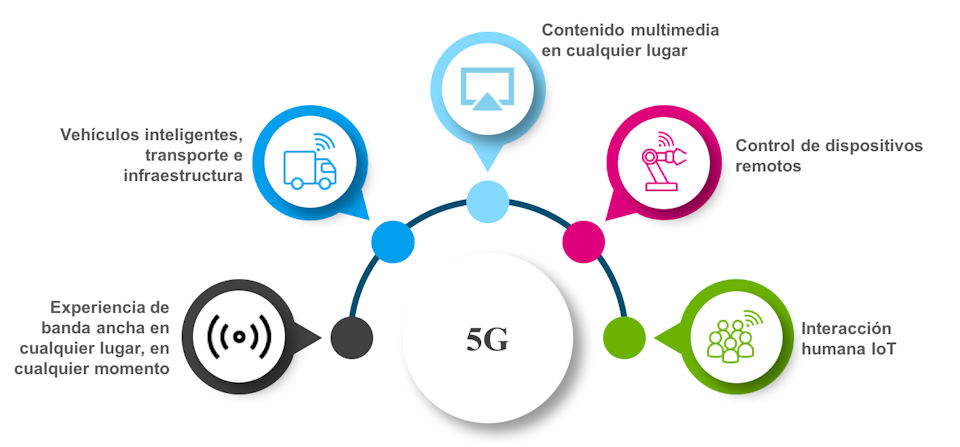Article
Introduction to 5G: the big leap towards the Internet of Things

5G will open the doors to new experiences and services that can only be imagined for now
Thanks to its opportunities for the industry and our connected society, 5G is the trend with the most repercussion at recent editions of Mobile World Congress.
For a comprehensive view of this technology that will revolutionize communications, we begin a series of articles that analyze 5G from multiple perspectives: the worldwide technology race, the global impact, and technical specifications such as spectrum and network architecture.
As an introduction, this first part will describe the general features, main uses and advantages over existing technologies.
The big leap
From the beginning of digital mobile telecommunications, every generation of technology (2G, 3G and 4G) has been developed to improve coverage efficiency and spectrum capacity, while enabling telecommunications networks to keep up with traffic growth. Although the widespread implementation of 4G is far from a reality, the leading telecommunications providers and manufacturers are already working on standardizing the fifth generation. 5G will be more than just a tool for sending more data in less time. It will also bring an array of possibilities for the Internet of Things (IoT), which will have to support millions of interacting devices.
This new technology is currently in an early development phase since one of its many obstacles is the matter of standardization. Despite this, key players agree that 5G is more than just a need because it is also marks a big leap towards the future.
What will we come across?
The basic premises defined for 5G once it has been standardized are:
Speed: 5G will reach speeds that are 100 times faster than the speed of LTE and 10 times faster than LTE-Advanced technology, an intermediate standard being deployed in Spain.
Low latency: Latency is the accumulation of various delays from when a request is sent until a response is received due to having the signal travel through the radio-electric medium. Decreasing latency in 5G is essential because this will make it possible to support services that differ from past technologies.
High density: Unlike past technologies that were extremely sensitive to the number of connected devices (like being at a crowded concert or football match, when connectivity is very limited), 5G will be able to support many devices at the same time and reach densities of up to 100 devices per m2.
Efficiency: This technology is expected to surpass the energy efficiency of 4G by 90%.
In December 2017, 3GPP (3rd Generation Partnership Project) approved the non-standalone 5G New Radio (NR) specifications. This 5G technology (the first standard with official approval) cannot operate autonomously and instead relies on LTE, the current technology. The call made using 5G on February 20 by Vodafone and Huawei from Castelldefels (Barcelona) to Madrid was the first of its kind with this standard.
A wishlist for the fifth generation of mobile communications
The list of requests and improvements for 5G is long and covers virtually every aspect within telecommunications and services. The main advances over existing technologies are:
Real time functionality: 5G is synonymous with fast response times, high availability, low latency and jitter. Latency and jitter are related concepts since they both refer to delays: latency is overall and applies to all the networks and jitter is an effect of non-connection oriented and packet-switched data networks. Latency should be less than 150 milliseconds and jitter should be under 100 milliseconds in order to adapt to the human ear’s sensitivity in real-time communications (such as VoIP).
Critical infrastructure: Up until now, the dimensioning of 3G and 4G networks had been limited by issues with the transport network, but with 5G, dimensioning will be based on the user experience to offer strong reliability and coverage.
Ultra-high capacity networks: High-quality coverage will be available and the technology will support multi-spectrum services to take maximum advantage of spectral capacity.
Virtualized infrastructure: Networks will be defined by software (SDN) and functionality (NFV). This refers to cloud-oriented network virtualization that will make it possible to improve scaling, cost efficiency and flexibility, which had not been possible up until now.
IoT and M2M: 5G will be able to handle millions of connected devices that send information periodically. “Everything connected” will become a reality.
Is 5G a need?
It is estimated that there will be 30 billion connected devices by 2020. A cell phone with Internet access has become a basic need, and the ability to make quality video calls or watch content via streaming without interruptions has become increasingly pressing. It seems that the 300 Mb/s download speed currently available on 4G networks will not be able to meet the future demands of users in terms of connectivity and speed.
In addition to connecting our smartphones and computers, the Internet of Things (IoT) strives for hyperconnectivity and the ability to simultaneously connect our homes (smart homes), vehicles, watches and cities to the network. Processing, analyzing and optimizing the vast amount of resulting data require constant stability. Since 4G cannot guarantee these multiple connections, 5G must be implemented.
Applications for which the response time is critical and that could be possible thanks to improved stability and shorter latency include:
Self-driving cars: 5G networks could provide a sufficiently fast response for their coordination, and this applies to vehicles communicating with a control center or with each other.
Videoconferencing: Having a conversation via an ultra-clear and high-resolution video will be possible thanks to real-time communication.
Entertainment: With a 5G connection, it will be possible to directly stream content on virtual reality devices.
Telemedicine: Doctors will be able to perform an operation or surgery remotely. Connection delays will be so minuscule that doctors will be able to operate 1,000 kilometers away using robots.

A journey through the evolution of technology
More than 30 years have passed since the emergence of “1G”, and the fifth generation of mobile networks is currently slated to be deployed in 2020. The evolution from what could be done with analog phones in the 1980s to what is currently possible has been nothing short of radical.
The first generation category includes phones that could only make calls, while the 1990s 2G refers to the emergence of digital telephony. 2001 marked the start of 3G, which made it possible to transfer multimedia files, establish continuous wireless connectivity and reach speeds that were up to seven times faster than standard phone connections, all with added security. 4G technology, also known as LTE, is the fastest to date, but it is not yet a global reality because certain SIM cards and devices are not compatible with it. We will begin to see the first commercial deployments of 5G as of 2020.
In lab tests conducted under very specific conditions, Etisalat, an Asian telecommunications provider with a presence in Africa and Eastern Europe, has reached a record speed of 71 Gb/s on 5G. However, it is estimated that the average speed in “real” conditions will be 10 Gb/s and what users actually experience will be 1 Gb/s. To put things into perspective, at these speeds it will be possible to download six seasons of Game of Thrones in Full HD in only 30 seconds.
From 4G to 5G: Major improvements in less than a decade
The activation of 4G began in 2012 and 5G is slated for 2020. Although the matter of standardization is still pending, the newer technology is expected to bring a number of improvements:
The implementation of 5G will be easier than that of 4G.
Fifth generation technology will enable 90% energy savings per service provided compared with 4G.
Latency in 5G will be under one millisecond and much lower than that of the previous technology, which averaged at 50 ms.
With 4G, connections are affected in crowded areas, but 5G will make it possible to simultaneously connect approximately 100 billion devices.
The frequencies used will be much higher with the new technology, which can reach from 6 GHz to 100 GHz. 4G does not use frequencies above 3 GHz.
Aside from the improved energy consumption that 5G will bring, one of the most important aspects of this technology will be the possibility of adding new services and use experiences for the everyday lives of users. Products and experiences that today can only be imagined, such as self-driving cars and telemedicine (eHealth), could become a reality thanks to the advances that are expected to arrive with 5G. The big leap towards the connected world.

